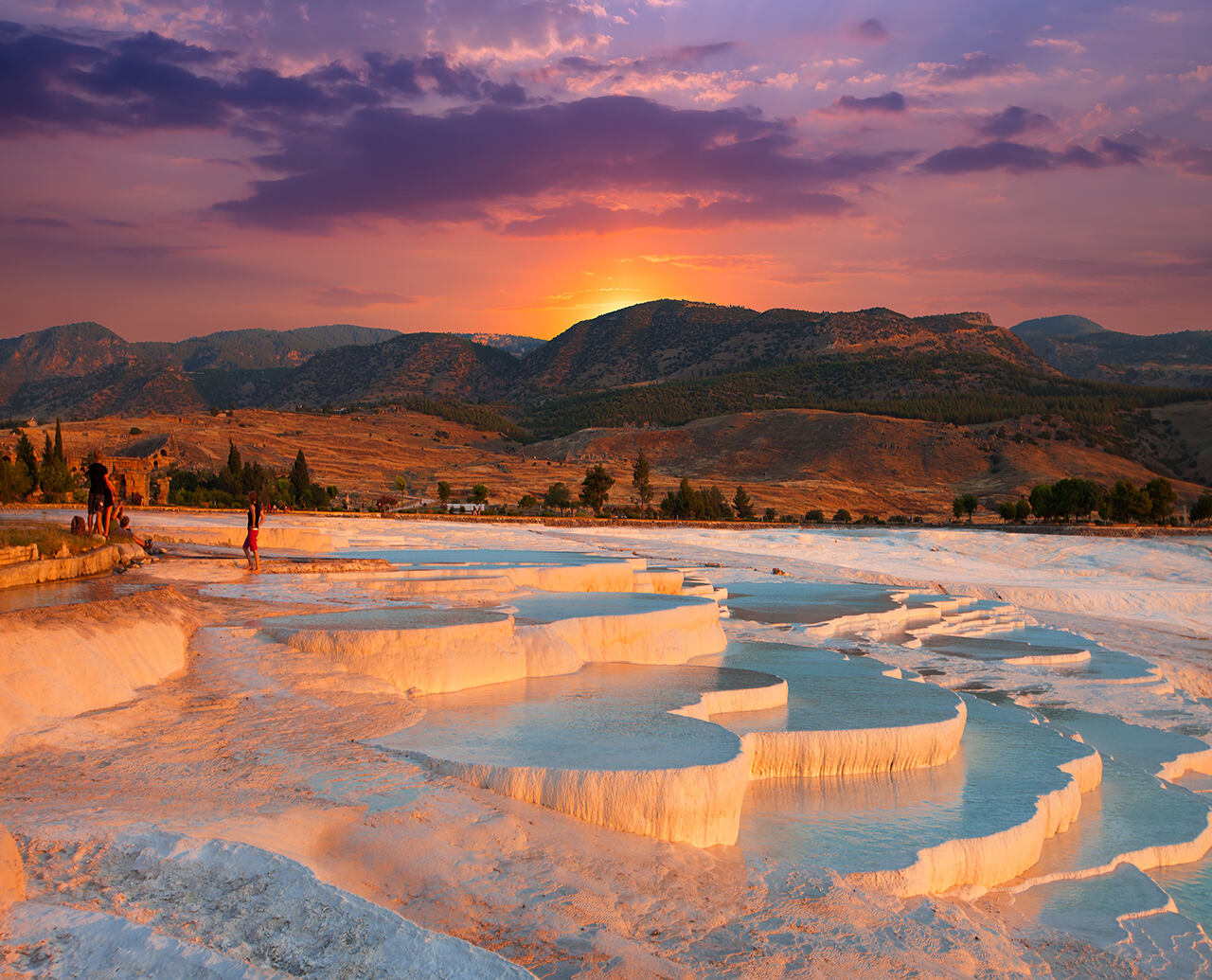
Pamukkale, often called the "Cotton Castle," is a natural wonder in Turkey that captivates visitors with its stunning white terraces and thermal waters. But what makes this place so special? Pamukkale is not just a pretty face; it’s a site rich in history, culture, and unique geological features. From ancient Roman ruins to its therapeutic hot springs, there’s a lot to uncover. Did you know that the terraces are formed by calcium deposits from the hot springs? Or that the ancient city of Hierapolis sits just above these terraces? Whether you're a history buff, nature lover, or just curious, these 38 facts about Pamukkale will give you a deeper appreciation for this UNESCO World Heritage site.
Key Takeaways:
- Pamukkale, meaning "Cotton Castle" in Turkish, is a UNESCO World Heritage Site known for its stunning white terraces and thermal waters. It has a rich historical background and attracts over 2 million tourists annually.
- The terraces are formed by mineral-rich thermal waters, and the site is home to diverse plant and animal species. Conservation efforts are in place to protect this natural wonder for future generations.
What is Pamukkale?
Pamukkale, meaning "Cotton Castle" in Turkish, is a natural wonder located in southwestern Turkey. Known for its stunning white terraces and thermal waters, it attracts millions of visitors each year. Let's dive into some fascinating facts about this unique destination.
-
Pamukkale is a UNESCO World Heritage Site, recognized for its cultural and natural significance.
-
The terraces are formed by travertine, a type of limestone deposited by mineral-rich thermal waters.
-
The thermal waters have been used for therapeutic purposes since ancient times.
The Unique Geology of Pamukkale
The geological formations at Pamukkale are nothing short of spectacular. The white terraces and thermal pools are a result of unique natural processes.
-
The thermal waters emerge from underground at a temperature of about 35°C (95°F).
-
The water contains high levels of calcium carbonate, which precipitates to form the travertine terraces.
-
Over time, the calcium carbonate hardens into travertine, creating the iconic white terraces.
Historical Significance of Pamukkale
Pamukkale is not just a natural wonder; it also has a rich historical background. The ancient city of Hierapolis was built on top of the terraces.
-
Hierapolis was founded in the 2nd century BC by the Attalid kings of Pergamon.
-
The city was known for its thermal baths, which were believed to have healing properties.
-
Hierapolis became a major center for arts, philosophy, and trade during the Roman period.
The Thermal Pools of Pamukkale
The thermal pools are one of the main attractions at Pamukkale. Visitors can bathe in these warm, mineral-rich waters.
-
The pools are believed to have therapeutic benefits, including relief from skin conditions and arthritis.
-
Cleopatra's Pool, a famous thermal pool, is said to have been a gift from Marc Antony to Cleopatra.
-
The water in the pools is constantly replenished by the thermal springs, ensuring a fresh supply of mineral-rich water.
Flora and Fauna of Pamukkale
Pamukkale is home to a variety of plant and animal species, some of which are unique to the area.
-
The area around Pamukkale supports a diverse range of plant species, including several types of wildflowers.
-
The thermal waters create a unique habitat for certain species of algae and bacteria.
-
The surrounding region is also home to various bird species, including storks and herons.
Tourism at Pamukkale
Pamukkale is a popular tourist destination, attracting visitors from all over the world.
-
Over 2 million tourists visit Pamukkale each year.
-
The site is open to visitors year-round, although the best time to visit is during the spring and autumn months.
-
Visitors are required to remove their shoes to protect the delicate travertine terraces.
Conservation Efforts
Preserving the natural beauty of Pamukkale is a priority for local authorities and conservationists.
-
Strict regulations are in place to limit the number of visitors and prevent damage to the terraces.
-
Efforts are being made to restore areas that have been damaged by tourism and environmental factors.
-
The thermal waters are carefully monitored to ensure they remain clean and mineral-rich.
Interesting Tidbits
Pamukkale has many interesting aspects that make it a unique destination.
-
The name "Cotton Castle" comes from the white appearance of the terraces, which resemble cotton fields.
-
Pamukkale has been featured in several films and TV shows due to its stunning scenery.
-
The site has been a popular destination for centuries, attracting visitors from ancient times to the present day.
The Ancient City of Hierapolis
Hierapolis, the ancient city atop Pamukkale, has its own set of fascinating facts.
-
The city was named after Hiera, the wife of the founder of Pergamon.
-
Hierapolis was known for its grand theater, which could seat up to 15,000 spectators.
-
The city also had a large necropolis, or cemetery, with over 1,200 tombs.
Modern-Day Pamukkale
Today, Pamukkale continues to be a place of wonder and relaxation.
-
The town of Pamukkale, located near the terraces, offers a range of accommodations and amenities for visitors.
-
Local cuisine includes dishes made with fresh, locally-sourced ingredients.
-
The area is also known for its wine production, with several vineyards located nearby.
Fun Facts About Pamukkale
Here are some fun and lesser-known facts about Pamukkale.
-
The terraces can change color depending on the time of day and the angle of the sunlight.
-
Pamukkale has been a popular honeymoon destination for couples from around the world.
-
The site is often compared to other natural wonders, such as Yellowstone National Park's Mammoth Hot Springs.
Pamukkale in Popular Culture
Pamukkale has made its mark in popular culture, appearing in various forms of media.
-
The terraces were featured in the James Bond film "Skyfall."
-
Pamukkale has been the subject of numerous documentaries and travel shows.
-
The site is a popular location for photography and social media posts.
The Future of Pamukkale
Looking ahead, Pamukkale continues to be a place of natural beauty and historical significance.
-
Ongoing research aims to better understand the geological processes that create the terraces.
-
Efforts are being made to promote sustainable tourism and protect the site for future generations.
Pamukkale's Wonders Await
Pamukkale's beauty and history make it a must-see. From its thermal springs to the ancient city of Hierapolis, there's so much to explore. The travertine terraces are a natural marvel, formed over millennia by mineral-rich waters. Visitors can walk barefoot on these terraces, feeling the warm water beneath their feet. The ancient ruins of Hierapolis offer a glimpse into the past, with well-preserved structures like the theater and necropolis.
Pamukkale isn't just about history and nature; it's also a place for relaxation. The thermal pools are known for their healing properties, attracting tourists seeking wellness. Whether you're a history buff, nature lover, or just looking to unwind, Pamukkale has something for everyone. So, pack your bags and get ready to experience one of Turkey's most unique destinations. Pamukkale's wonders are waiting for you.
Frequently Asked Questions
Was this page helpful?
Our commitment to delivering trustworthy and engaging content is at the heart of what we do. Each fact on our site is contributed by real users like you, bringing a wealth of diverse insights and information. To ensure the highest standards of accuracy and reliability, our dedicated editors meticulously review each submission. This process guarantees that the facts we share are not only fascinating but also credible. Trust in our commitment to quality and authenticity as you explore and learn with us.


